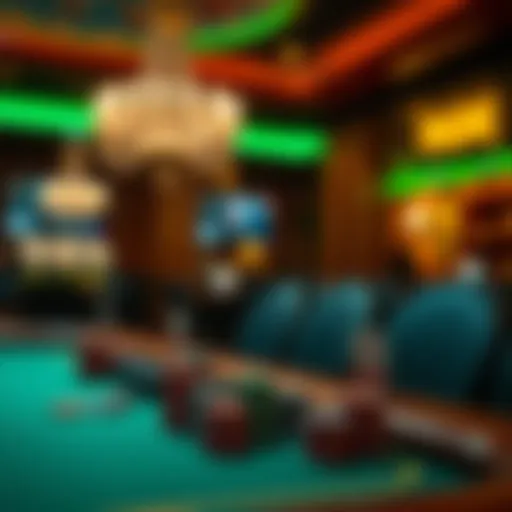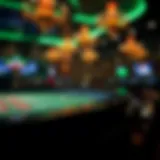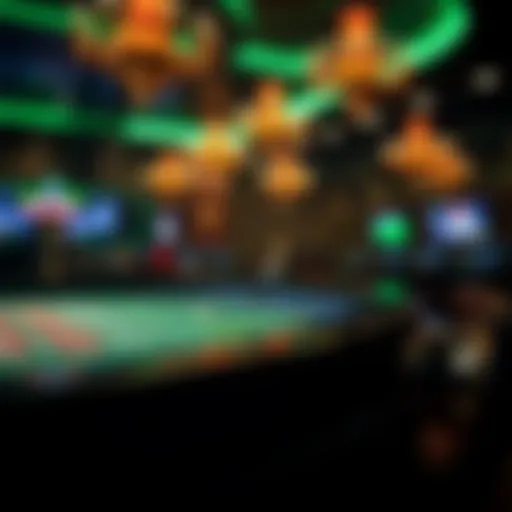Mastering Winning Odds in Blackjack Strategy
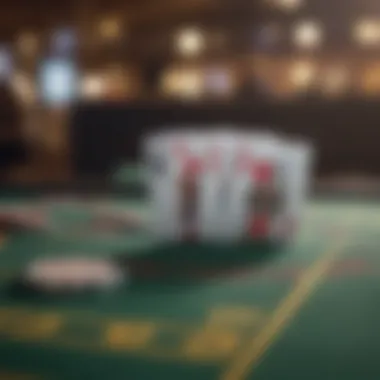

Intro
Blackjack isn't just a game of luck; it’s a complex interplay of mathematics, psychology, and strategy. Whether you're a novice sitting at the table for the first time or a seasoned player looking to sharpen your skills, understanding the winning odds in blackjack can make all the difference between going home broke or with a little extra change in your pocket.
One of the most common misconceptions about blackjack is that it is primarily about chance, but when you peel back the layers, you'll find that sound tactics and knowledge of odds can significantly sway the odds in your favor. In this article, we'll delve into various facets of the game, from fundamental strategies to advanced techniques that even seasoned players might overlook.
As we explore this topic, we'll address various strategies that can be applied throughout the game. Additionally, we’ll take a critical look at common traps that gamblers often fall into when they don't pay attention to the broader landscape of blackjack play, including house rules and betting patterns. By the end, you’ll have a well-rounded understanding of how to approach the game and harness the various tools and strategies available.
"Card counting might sound complicated, but it's just a way to keep track of the ratio of high cards to low cards remaining in the deck. A little know-how can take you far at the tables."
Let's get started on this journey to uncover the intricacies of blackjack, and by doing so, you’ll be better equipped to navigate your next gaming experience.
Prologue to Blackjack and Its Popularity
Blackjack's allure stretches far and wide, transcending not only casino floors but also entering the realm of social gatherings, where friendly bets often spice up an evening. The charm of the game lies not only in its potential for monetary gain but also in its rich history and dynamic gameplay. Understanding why blackjack has captured the hearts of players worldwide is pivotal for grasping its significance in the gambling world.
Historical Context of Blackjack
The origins of blackjack trace back to the early 17th century in Spain, where a game called "ventiuna"—meaning twenty-one—was gaining traction. It wasn't long before the French modified it into "vingt-et-un," further popularizing the game across Europe. When blackjack made its way to the United States, particularly during the gold rush of the 1850s, it began to evolve into the game as we know it today. The introduction of the bonus payout for a "blackjack"—an ace paired with a black Jack (clubs or spades)—helped cement its allure. This historical journey reflects not only the adaptation of the game but the cultural shifts that influenced its rules and appeal.
Cultural Significance of the Game
Blackjack isn't merely a game of chance; it serves as a cultural touchstone for various demographics. The game has permeated literature, film, and even philosophies around gambling, portraying it as a test of wits, psychological acuity, and chance. It stands as a metaphor for various life situations, where calculated risks lead to potential rewards.
- In Las Vegas, high-stakes blackjack tables attract players from around the globe, showcasing not just luck but skill and strategy. This creates an environment of prestige and excitement.
- Beyond casino walls, it often features in popular culture, reinforcing its status as a quintessential gambling game, leading to increased engagement and interest.
The combination of its historical evolution and cultural significance helps paint a vivid picture of why blackjack remains so prevalent today. It's more than just a game; it's a narrative woven into the fabric of gambling lore.
Basic Principles of Blackjack
Understanding the basic principles of blackjack is crucial for any player looking to maximize their chances of success at the table. At its core, this section focuses on the foundational aspects that govern the game, including its structure, rules, and objectives. By familiarizing oneself with these elements, players can formulate effective strategies and improve their gameplay significantly.
Game Structure and Rules
Blackjack is played in a casino setting with one or more decks of standard playing cards. The game typically involves a dealer and one or more players. Each player competes against the dealer, striving to achieve a hand value as close to 21 as possible without exceeding it. The basic structure is simple, yet the nuances within the rules can greatly influence a player's success and the odds of winning.
Initial dealing begins with each player receiving two cards. The dealer also gets two cards; one is face up and the other face down. It's important to remember that numbered cards hold their face value, while jacks, queens, and kings are worth ten, and aces can count as either one or eleven, depending on the player’s preference.
Here are some key rules to grasp:
- Players can choose to hit (take another card) or stand (keep their current hand).
- A player can double down after their initial two cards, doubling their bet in exchange for one additional card.
- Splitting is allowed when the initial two cards are of the same value, turning them into two separate hands.
- The dealer must hit until reaching a total of 17 or higher, which introduces the concept of the house edge.
This structure creates an engaging dynamic, as players must assess their hands and make strategic decisions in response to the dealer's visible card.
Understanding the Objective
The main objective in blackjack is to beat the dealer by either having a hand total greater than the dealer’s without going over 21, or by the dealer busting — going over 21. This means players aren't just focused on their own hands but must also keep a close eye on the dealer's potential hands as well.
Achievement of a 'blackjack' — an ace combined with a ten-value card — results in a win that usually pays out 3:2, highlighting the advantage this hand has. Understanding how to play your cards right comes down to grasping this primary goal.
Central objectives also include:
- Taking calculated risks while hitting or standing
- Learning when to double down for optimal returns
- Deciding when a split could yield favorable hands
Successfully navigating these basic principles lays the groundwork for developing further strategies that can lead to a more satisfying experience in blackjack.
Knowing the rules and recognizing the objective enables players to build confidence and make informed decisions that affect winning odds. It ensures that whether you are a novice or more seasoned player, you can approach the game with the knowledge needed to elevate your play and enjoyment.
Mathematics Behind Winning Odds
Understanding the mathematics behind winning odds in blackjack isn't just an academic exercise. It's the backbone upon which most successful strategies rest. Mastering these concepts can significantly enhance your chances of winning, giving you a firmer grasp on how to beat the house edge. When you delve into these calculations, you discover not only the mechanics of the game but also how your decisions can impact the outcome. This section will help you comprehend the key principles that govern the game and enable you to make informed choices.
Probability Fundamentals in Blackjack
At its core, blackjack revolves around probability. Each decision you make is influenced by a mix of what you hold, what the dealer has, and the unseen cards. To illustrate this, consider the chances of being dealt a blackjack (an Ace and a 10-point card) on the initial hand. This occurrence happens roughly 4.75% of the time; while it may seem slim, it underscores how crucial every single card becomes in your strategy.
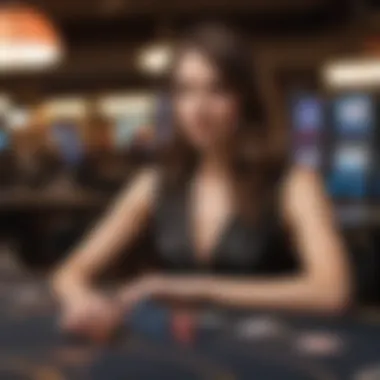

- In a standard 52-card deck:
- There are 4 Aces and 16 cards worth ten points.
- Probability calculation: 4 Aces x 16 tens / Total combinations = 0.0475 or 4.75%.
Understanding probabilities helps you navigate through decisions like whether to hit or stand, and it raises your awareness of the house edge. For instance, if the dealer shows a 6, there’s a solid reason for you to stand on lower sums, as the chances of the dealer busting increase when they face bust cards.
Calculating Expected Value
Expected value (EV) is a fundamental concept that can guide your every move in blackjack. Each action you take, whether hitting, standing, doubling down, or splitting, has a distinct EV. Essentially, this calculation shows you the average amount you expect to win or lose per bet over the long haul.
To compute expected value, you need to know:
- The rewards of winning an action.
- The probabilities of winning or losing that action.
For example, if doubling down gives you a potential payout of 3:2, but your odds of winning are 55%, your expected value for that move can be calculated as follows:
- EV = (Probability of Winning x Payout) - (Probability of Losing x Bet)
- EV = (0.55 x 1.5) - (0.45 x 1) = 0.825 - 0.45 = 0.375.
This means, on average, you can expect to gain about 37.5 cents on every dollar bet when doubling down in that scenario. Recognizing these values equips you to make strategic choices that align with the mathematical advantages rather than emotional responses or hunches.
"Even a small edge in understanding the odds can tip the scales in your favor. Every card counts in blackjack."
In summary, knowing how to navigate probabilities and expected values might just be your ticket to maximizing those winning odds at the blackjack table. By grasping these core math principles, you’ll find that many decisions become clearer, and you gain a strong toolset in your gambling arsenal.
Factors Impacting Winning Odds
The odds of winning in blackjack are not set in stone. They fluctuate based on a variety of factors that players must navigate savvy. Understanding these elements is pivotal for anyone looking to improve their standing at the table. From the inherent house edge to the nuances of player choices, each component plays a crucial role. Whether you’re an amateur taking your first steps or a seasoned player trying to refine your technique, grasping these factors can make or break your game.
House Edge Explained
The house edge in blackjack is more than just a statistic—it's the built-in advantage the casino holds over players. Typically, this edge hovers around 0.5% when players use basic strategies. However, this number can swing dramatically based on game rules. For instance, variations like Spanish 21 might tilt the scale against the player more than traditional blackjack.
Understanding the house edge helps players set realistic expectations. The lower the edge, the better the odds for the player. Here are some aspects that can influence the house edge:
- Number of Decks: Fewer decks mean high odds for players since fewer cards are involved, reducing the unpredictability.
- Payouts on Blackjacks: A typical payout is 3:2, but some establishments offer 6:5, which increases the house's advantage.
- Rules on Doubling and Splitting: Restrictions on gameplay can impact the overall odds significantly.
"Knowledge is power, and in blackjack, understanding the house edge is akin to holding the strongest hand."
Player Decisions and Their Consequences
Your choices at the table matter, perhaps more than you realize. Each action—hitting, standing, splitting, or doubling down—carries weight. An inexperienced player might make impulsive decisions that can skew the probabilities. Instead, employing a clear strategy backed by mathematical principles could tilt the odds in your favor.
Some key player decisions that affect winning odds include:
- When to Hit or Stand: Knowing when to take a risk and when to hold your ground can be pivotal. A basic strategy guide offers clarity on the best choices based on various hand combinations.
- Splitting vs. Not Splitting: Decisions around splitting pairs can be crucial. For example, while splitting aces offers a chance for two strong hands, splitting tens generally should be avoided.
- Doubling Down Strategy: This moves can amplify your winnings, but carefully analyzing your hand against the dealer's is fundamental.
Influence of Deck Penetration
Deck penetration refers to the percentage of cards dealt from a shoe before reshuffling occurs. Greater penetration is favorable for skilled players, particularly those using card counting methods. A deeper deck penetration allows for improved prediction of high-value cards remaining in the shoe.
Considerations include:
- Card Counting Viability: The more you see the cards dealt, the better your chances of adjusting your bets accordingly based on the remaining deck's composition.
- Dealer’s Behavior: Being aware of the dealer’s pace and the reshuffle point can give clever players an edge.
- Table Rules and Reshuffle Points: The dealer reshuffle at different depths can impact the effectiveness of strategies like card counting.
By understanding how house rules and player choices shape the winning odds, players can engage in smarter, more calculated gameplay. As blackjack evolves, so should one's strategy and comprehension of the game.
Basic Strategy for Maximizing Winning Odds
When it comes to blackjack, having a solid strategy in place is akin to possessing a map while traversing uncharted territory. Mastering the basic strategy enables players to systematically improve their odds at the table, making informed decisions based on the cards in play.
First and foremost, the essence of basic strategy lies in mathematically backed decisions. Unlike relying on gut feelings or hunches, which often lead down a slippery slope, the basic strategy is developed through probability and the understanding of the game’s dynamics. Whether you are a novice or an experienced player, knowing when to hit, stand, split, or double down can feel like having the upper hand in a duel.
The benefits are clear. By adhering to a basic strategy, players can significantly reduce the house edge, which often hovers around 1% or less when optimal tactics are employed. This means your chances of walking away with winnings increase. Also, as you become more familiar with these strategies, each session at the table can transform from a gamble of chance into a calculated endeavor, leading to more consistent results over time.
Fundamental Strategy Charts


One of the cornerstones of implementing a basic strategy is the utilization of fundamental strategy charts. These charts outline the most strategic decisions based on the player’s hand against the dealer's up card. They serve as an invaluable resource for players looking to optimize their moves.
Consider the following key elements of the charts:
- Player Hand: The total value of your cards.
- Dealer Up Card: The visible card of the dealer.
- Recommended Action: The suggested move, whether it be hitting, standing, splitting, or doubling down.
The charts can vary based on whether the game is played with one deck or multiple decks. Therefore, it’s essential to use the right chart that corresponds to the rules of the specific table. For example, if you're holding a hard 16 and the dealer shows a 10, the chart may suggest you surrender if that option is available, otherwise, hitting could be your last option. Overall, these charts simplify decision-making immensely.
When to Hit, Stand, Split, or Double Down
Knowing when to take action is key to success in blackjack. Each of the possible actions—hitting, standing, splitting, or doubling down—plays a crucial role, depending on the hand value and the dealer's up card.
- Hit when you think your total is too low to beat the dealer or you have a soft hand (an Ace counted as 11).
- Stand if you’re confident your total is strong enough to win against the dealer without drawing additional cards.
- Split a pair (e.g., two 8s) if you want to create two separate hands, thus enhancing your chances of winning.
- Double Down when you believe your next card might land you a winning hand but are willing to risk only one additional bet.
It's essential to continuously evaluate both your hand and the dealer's up card. For instance, if you hold a 10 and an Ace, you may want to double down against a dealer showing a weak card like a 4 or 5, increasing your potential gain. Remember, the game’s structure is designed to foster smart decision-making rather than blind luck.
Always keep in mind that blackjack isn't merely a game of chance; it’s a game of skill, strategy, and calculated risk.
The right moves can change the tide in your favor. Keep practicing these strategies, reflect on your play, and adjust when necessary, and you’ll find that blackjack becomes not just a game, but an engaging puzzle waiting to be solved.
Advanced Strategies for Experienced Players
Navigating the world of blackjack is not just about knowing how to hit or stand; it's about what you do with that knowledge. As players sink deeper into the game, they often seek out advanced strategies to refine their skills and increase their potential winnings. Understanding these techniques is crucial, for they can transform a player from a casual participant into a formidable opponent at the table.
Card Counting Techniques
Card counting isn't just a ploy from the movies; it's a legitimate method to gain an edge over the house. While some may dismiss it as mere folklore, the reality is that this skill can immensely boost a player's success rate.
The principle behind card counting is relatively straightforward. By keeping track of the ratio of high to low cards remaining in the deck, players can adjust their bets and decisions based on the current game dynamics. A player employing basic card counting typically starts with a specific count based on the cards that have been dealt.
The most popular method is the Hi-Lo strategy. Here’s how it works:
- Assign values to cards:
- 2-6 become +1
- 7-9 are neutral (0)
- 10-Ace become -1
Players maintain a running count, adding and subtracting the values as cards are revealed. A higher positive count signals that more high cards are left in the deck, which generally favors the player. As a result, betting should be increased during this period. Conversely, if the count is negative, players might consider minimizing their stakes.
The skill of counting cards requires practice and discipline; it’s akin to learning a new language.
Bet Sizing Strategies
Once a player masters card counting, the next step is to implement effective bet sizing strategies. The objective is not just to win one hand but to maximize gains over time. Adjusting your bets according to your confidence in the count can be a game-changer.
Key Aspects of Bet Sizing:
- Flat Betting: This involves wagering the same amount on every hand regardless of the count. It’s a safe approach for beginners or those adopting a conservative strategy.
- Progressive Betting: This method involves increasing your bet size after a winning hand. If positive counts favor the player, this strategy capitalizes on potential profitable runs.
- Reverse Martingale: Here, you double your bet after a win and revert back to the original stake after a loss, banking profits while managing your losses.
Finding the right balance can take some time. Players should consider their bankroll limitations and risk tolerance when determining how aggressive their betting strategy should be. A misjudged bet can lead to rapid losses, while a well-timed increase can enhance payouts.
Understanding Variations of Blackjack
Blackjack is not a one-size-fits-all game; its countless variations offer unique twists that can significantly affect gameplay and winning odds. Understanding these differences is crucial for both new players and seasoned enthusiasts looking to get an edge at the tables. Variations can impact not just the rules but also the strategy and psychological aspects of the game. Analyzing these variations allows players to tailor their approach based on personal preferences and game conditions.
Common Variants and Their Odds
Several common variants of blackjack have gained popularity in casinos and online platforms alike. Each variant comes with its own set of rules that can change the odds of winning. Take, for example, the following variations:
- Classic Blackjack: The traditional version, offering a house edge around 0.5% when played with optimal strategy.
- European Blackjack: In this variant, the dealer receives only one card face up initially, reducing the possibility of busting and affecting player strategy.
- Spanish 21: This version removes all tens from the deck, which raises the house edge to about 0.4%, but offers several player-friendly rules like bonus payouts for certain hands.
- Pontoon: A variant popular in Australia, where players aim to get the best hand, but with specific rules like the dealer hiding both cards.
Evaluating these variants not only sheds light on the odds associated with each but also how minor rule adjustments can influence decisions. Players must consider these factors to create an effective strategy tailored to the specific game they choose to play.
Exotic Blackjack Games and Their Appeal
Beyond the typical variants, there exists a variety of exotic blackjack games that capture the interest of more adventurous players. These games may not be widely played but offer unique features and thrills.
For instance:
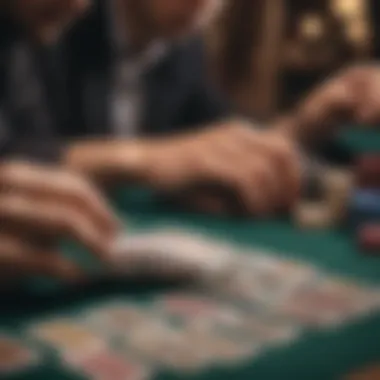

- Blackjack Switch: Players are dealt two hands and can switch the second card between those hands. This adds an exciting layer of strategy, although the house edge is higher.
- Double Exposure Blackjack: In this variant, both of the dealer's cards are exposed from the beginning, granting players a better opportunity to decide. However, the house edge increases due to adjusted payouts on blackjack.
- Vegas Strip Blackjack: This variant allows players to double down on any two cards and splits up to four hands, but it also adjusts payouts and rules for the dealer;
These exotic games provide a fresh perspective for players who find the standard rules monotonous. They also introduce elements of chance and skill, pushing players to adapt their strategies continually. Indeed, engaging with these variations can be both a challenge and a thrill, sharpening one's skills while maintaining an entertaining gambling experience.
"Whether you’re chasing the classic vibes or diving into a new variant, knowing your blackjack options can lead to smarter plays and better outcomes."
Understanding these variations, along with the odds they present, allows players to not only enhance their gameplay but also to enjoy a richer and more diverse casino experience. Players often find that experimenting with various forms of blackjack helps them grasp concepts more profoundly and develop a more adaptable approach to the game.
Psychology of Playing Blackjack
Understanding the psychological aspects of playing blackjack is crucial for anyone looking to improve their odds at the table. The game is not only a battle against the house but also a mental contest against oneself and other players. In gambling, keeping a cool head can mean the difference between a hefty win and a hefty loss.
Cognitive Biases in Decision Making
Cognitive biases are mental shortcuts our brains take that can lead to flawed judgment. In blackjack, these biases can manifest in various ways:
- Confirmation Bias: This is when players stick to a strategy simply because they believe it works, ignoring outcomes that contradict their beliefs. For instance, if someone believes doubling down is always beneficial, they'll focus on the wins but overlook the losses that occur when the strategy fails.
- Illusion of Control: Players might think they have more control over the game than they really do. This can lead someone to make risky bets, believing they can influence the card distribution, which is entirely based on chance.
- Gambler’s Fallacy: This is a common misconception where players believe that past events affect future outcomes. For instance, if a player has lost several hands in a row, they might think it's “due” for a win, leading them to increase their bets without regard for the odds.
By recognizing these biases, players can work towards creating more rational betting strategies, which can enhance their chances of winning in the long run.
Emotional Factors Affecting Play
Emotion plays a significant role when seated at the blackjack table. Many gamblers can attest that how one feels can dictate how they perform:
- Tilt: This is a poker term that's equally applicable in blackjack. If a player experiences frustration or anger after a series of bad hands, their decision-making can deteriorate. They might chase losses or make impulsive bets that go against their strategic plan.
- Excitement and euphoria: Winning can induce a high that may compel players to play aggressively, abandoning their careful strategies led by fear of letting go of their winnings too soon.
- Anxiety: Conversely, the pressure of losing can lead to anxious decisions, such as playing defensively or making hasty moves, which can ultimately affect the game's outcome.
Myths and Misconceptions About Blackjack
The realm of blackjack is fraught with various myths and misconceptions that can lead players astray. Understanding these false notions is crucial for anyone looking to enhance their gameplay. Misunderstanding the game can mean the difference between a successful strategy and a costly error. By debunking these myths, players can cultivate a clearer understanding of the game's structure and the actual odds they face at the table.
Debunking Common Myths
One of the most pervasive myths in blackjack circles is the idea that previous results impact future outcomes. For instance, many players believe in the concept of hot and cold streaks. However, blackjack operates on the principle of independent events—the outcome of one hand does not affect the next. This means that if one player frequently loses, it doesn't imply that another will have better luck in the coming hands.
Another common misconception is that card counting is an infallible method for winning. While card counting offers an advantage when done correctly, it requires immense concentration and skill. Moreover, casinos are increasingly employing countermeasures to thwart counters, such as shuffling frequently or using multiple decks. In the right hands, card counting can shift the odds, but it is not a foolproof strategy. In fact, most players may find it more advantageous to rely on solid basic strategy.
Additionally, there is the belief that splitting aces and eights guarantees a win. While this move is statistically favorable, it doesn't always lead to guaranteed success. Splitting gives players a better chance at two strong hands, but it also means that they could still end up with poor outcomes. Understanding this nuance is imperative for making informed decisions at the table.
"Believing in myths can blind players to the rational strategies available, leading to poor choices and losses."
Understanding Hot and Cold Streaks
The concept of hot and cold streaks is another frequent misperception that needs clarity. Players often cloud their judgment by attributing their wins or losses to external factors, such as the dealer's technique or the table's atmosphere. In reality, these streaks are merely chance at play. Each hand is a separate event governed by the rules of probability.
Players might get fixated on the idea that betting more during a winning streak will dramatically increase their chances of winning big. While there may be a psychological boost during a perceived hot streak, it is paramount to remember that the odds fundamentally remain unchanged. Betting as a reaction to past results can lead to losses rather than significant gains.
On the flip side, when experiencing a losing streak, players might think that a win is due. This fallacy, known as the gambler's fallacy, keeps players tethered to the notion that luck must eventually even out. Yet, the mathematical structure of blackjack does not operate on such principles. Losses can, and do, occur back-to-back without any inherent "making up for it" in future hands.
In essence, recognizing that streaks are simply a product of random chance can help dispel the anxiety and misplaced beliefs many players harbor. This allows for a more focused approach, free from the distractions of superstition and emotion.
Culmination: Enhancing Your Blackjack Experience
After diving into the intricacies of blackjack and its odds, one can appreciate the substantial advantages of understanding not just the game itself, but the overall experience associated with it. Engaging in blackjack is more than just a gamble; it is a nuanced interplay of strategy, math, and psychology. Each session at the table can be a reflection of what you’ve learned, as you integrate the strategies discussed throughout this article into your practice.
Focusing on elevating your experience means recognizing the importance of balance between enjoyment and the tactical elements of the game. The insights gathered on mathematics and player behavior can enable you to make choices that enhance your chances of winning, but remember to keep the fun in the forefront.
Reflecting on Strategy and Practice
When you reflect on your blackjack strategies, it's invaluable to analyze past games to identify what decisions led to wins or losses. Taking a step back to review key moments helps sharpen your future gameplay. Consider the following:
- What scenarios caused you to deviate from your strategy?
- Did emotional factors skew your judgment?
- How did your understanding of the game evolve with experience?
Additionally, practice is pivotal. This could mean playing online for free to test new strategies without financial risk or sitting at a low-stakes table to build confidence. Engaging with communities, whether online or offline, can also provide fresh perspectives and tactics that may align well with your personal style. Around tables, the wisdom of the crowd can often lead to revelation.
"Strategy is not about being right or wrong, but about making the choices that create opportunities for success."
Continued Learning and Adaptation
In the dynamic world of gambling, the journey doesn't end with just mastering blackjack basics. Continuous learning and adaptation are crucial for sustained success. Markets change, dealer behaviors shift, and innovations arise in game formats. Engaging with the latest research, blogs, or casino forums can keep you informed on trends and emerging strategies.
Consider the following paths for ongoing development:
- Stay Current: Regularly read articles or watch videos about blackjack strategies and odds. Websites and platforms like Wikipedia, Britannica, and gaming communities on Reddit are excellent resources.
- Join Forums: Participate in discussions to benefit from the experiences of fellow players, allowing you to refine your approach based on real-world insights.
- Experiment: Don’t hesitate to try out different strategies in controlled settings. Hands-on practice can often solidify knowledge more than theory alone.









